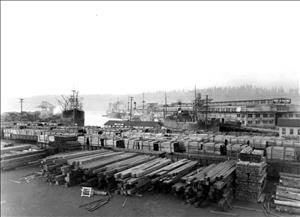On November 5, 1918, voters in Pierce County create a municipally owned Port of Tacoma. The vote -- 15,054 in favor, 3,429 against - passes by a 5 to 1 margin. Until the vote, the Tacoma waterfront was privately owned by railroads (especially the Milwaukee Road) and by such firms as Todd Shipyards and the St. Paul and Tacoma Lumber Co. Two municipally owned docks were the only public property on the extensive waterfront of Commencement Bay.
The Tacoma and Pierce County economy was booming during these years of World War I, with lumber at the center. Douglas fir went to ship construction and spruce went to aircraft construction. Besides the many lumber and shingle mills, there were shipyards, flour mills, and the electrometallurgy (especially copper) and electrochemical industries. The overwhelming vote in favor of a publicly owned port came in the context of this robust and growing economy.
In 1911 the Washington State Legislature had passed a law enabling municipalities to form port districts. In 1912, Pierce County voters turned down the port by a narrow margin. Some of the opponents were farmers outside Tacoma who didn't see why the present system of getting goods to the waterfront wasn't sufficient.
Preceding the 1918 election an intense campaign was mounted. To reach the farmers, advocates noted that 30 percent of the crop of potatoes and apples had rotted in 1917 because of lack of proper warehousing. Port advocates noted that private docks were turning away cargo. They felt that the city with a modern, publicly owned port would reap the advantage of the ever-increasing maritime commerce whereas a city like Tacoma at the time, with inadequate docking, antiquated warehousing, and lack of a coordinated port authority would lose this commerce.
A Vote For Progress
The Tacoma Daily Ledger editorialized on the eve of the elections:
"This is one of the most important elections Pierce has yet seen."The voters will decide between lethargy and growth; whether a portion of the Pacific trade of tomorrow shall be brought here, or whether more wide-awake communities shall wax greatly from it without competition; whether the people here can see visions and work to realize them, or whether they prefer quiet, unmolested by any noise of Material advancement.
"Vote for progress, for more work, for increased value of property, for larger population, for better markets for products of the soil. No man should stand against the best interests of Tacoma. Therefore, every man should vote for the Port proposal.
"The mammoth commerce of the coming years will be handled by the ports that dare" (quoted in The Working Waterfront, 45).
Voters agreed, and the Port of Tacoma came into existence. Chester Thorne, a banker, Edward Kloss, a longshore official, and Charles W. Orton, a Sumner fruit and dairy farmer were elected Port Commissioners. In 1919 Pierce County citizens passed a $2.5 million bond issue to plan and build facilities. The Port of Tacoma began development on 240 acres of tideflats.

